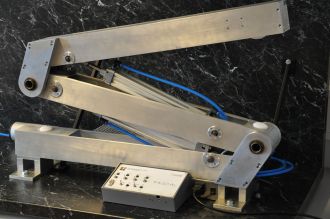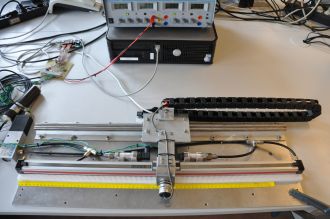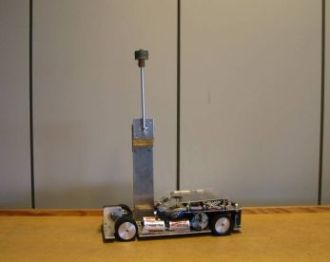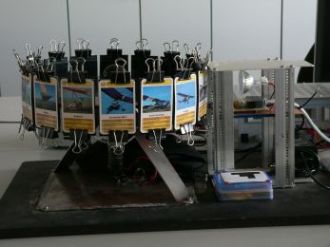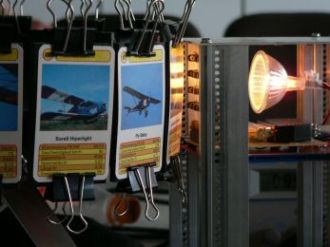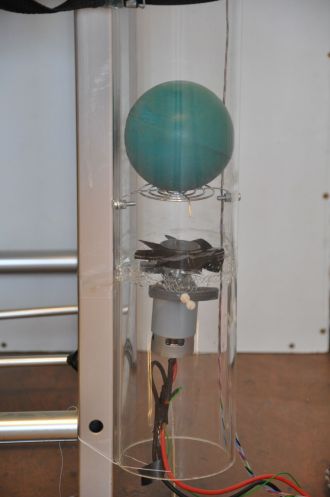The compressibility of air along with strong friction (stick-slip-effect) and the time-variant behavior of pneumatics lead to severe challenges for controller design. These are emphasized by the kinematic as well as kinetic and pneumatic couplings of both degrees of freedom. PASCAL is hence a challenging, but easy to operate testbed for smart and self-optimizing controllers (SHARCS).
| platform: | 2 DoF aluminum frame (8 × 8 cm) with 120° turning angle at each axis |
| size: | upper arm length 70 cm forearm length 70 cm |
| sensors: | 2 incremental encoders 5 pressure sensors |
| actuators: | pneumatic cylinders with 63 mm diameter and 25 cm displacement by Festo (upper arm) 32 mm diameter and 25 cm displacement by Festo (forearm) two proportional valves (Festo MPYE-5-1/8-HF-010-B) 6 bar air supply |
| hardware: | onsite FPGA + external PC (via USB) |
| platform: | base plate of 74 × 26 cm with a cart of 13.5 × 10 cm |
| sensors: | 1 incremental encoder 3 pressure sensors |
| actuators: | rodless cylinder (Hörbiger Origo) with 16 mm diameter and 62 cm displacement 1 proportional valve (Festo MPYE-5-1/8-HF-010-B) 6 bar air supply |
| hardware: | onsite FPGA + external PC (via USB) |
It can be operated in two modes: either as a low cost embedded system with an 8-bit microcontroller (Motorola 68HC11) or connected to an external PC. The later mode is used for investigations on control architectures as well as learning and self-optimizing controllers (SHARCS).
| platform: | aluminum chassis |
| size: | chassis: 29.5 × 13 × 25 cm pendulum length: 16.7 cm |
| weight: | 1.6 kg for chassis 80 g for pendulum |
| sensors: | 2 incremental encoders |
| actuators: | 12 V DC-motor (560 class) |
| hardware: | onboard microcontroller Motorola 68CH11 or onsite FPGA + external PC (via USB) |
|
This is standard set-up offered by Quanser. Because it has less severe control problems than the pendulum cart, this inverted pendulum acts as a starting point for controller design. Transfering the principles to the pendulum cart allows drawing more general conclusions. |
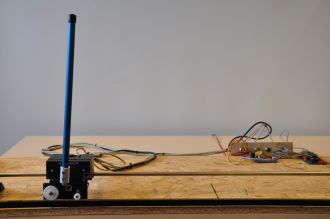
|
| platform: | inverted pendulum by Quansar mounted on a wooden base plate of 120 * 40 cm |
| size: | displacement: 90 cm pendulum length: 31.5 cm |
| sensors: | 2 incremental encoders |
| actuators: | electric gear drive |
| hardware: | onsite FPGA + external PC (via USB) |
| platform: | 16 cards mounted at rotating table with peripheral speed up to 2 m/s |
| size: | picture of cards: 5.3 × 4.9 cm diameter of rotating table 35 cm |
| sensors: | 16 photodiodes |
| actuators: | electric gear drive |
| hardware: | 16 channel AD-converter (16 bit) plus onsite FPGA + external PC (via USB) |
| platform: | plexiglass tube with inner diameter of 9.2 cm |
| size: | length 185 cm |
| sensors: | 1 ultrasonic distance sensor or digital camera |
| actuators: | directly driven propeller of 7 cm diameter |
| hardware: | onsite FPGA + external PC (via USB) |
